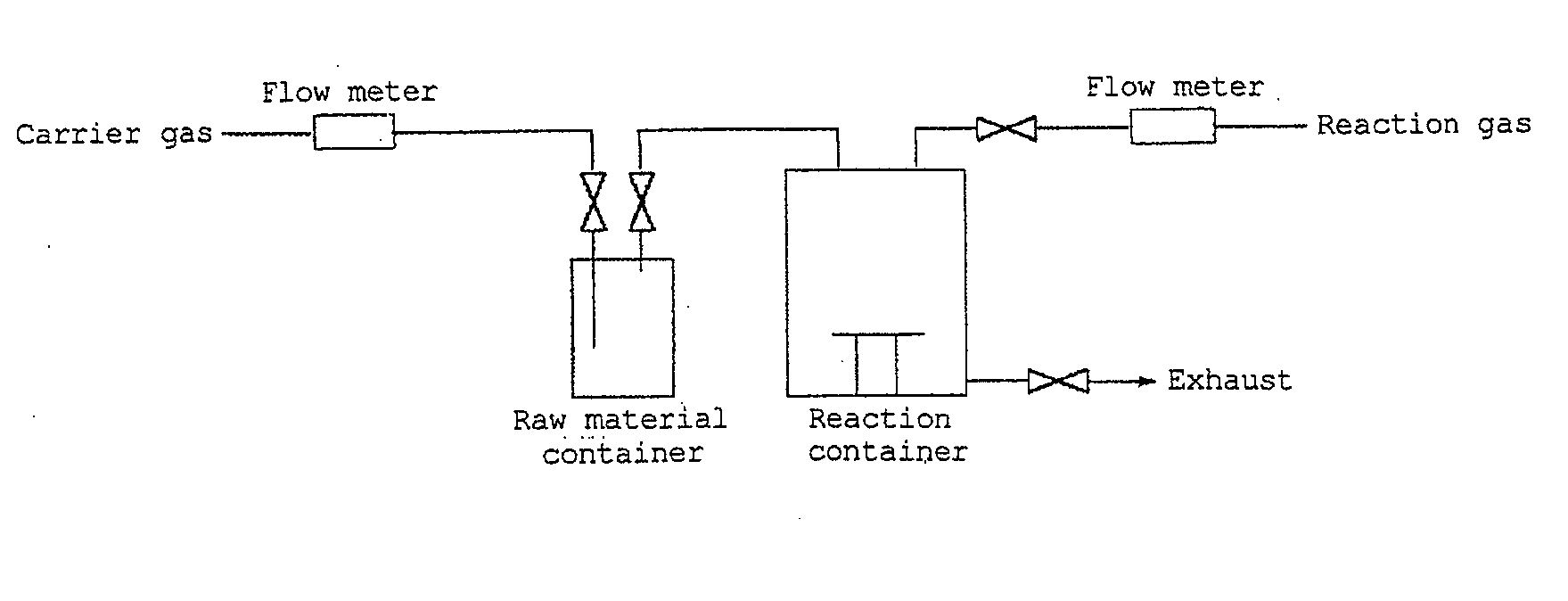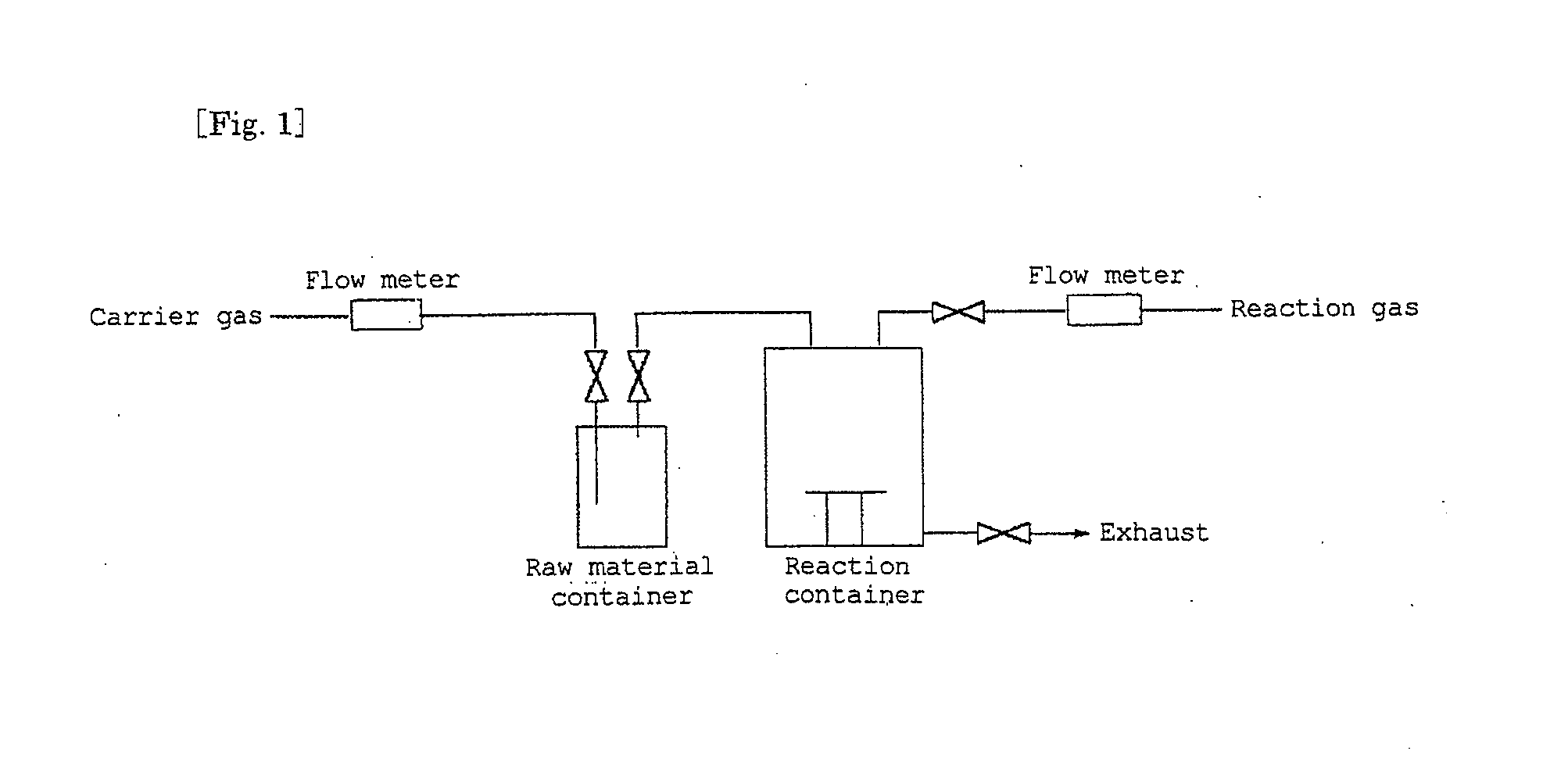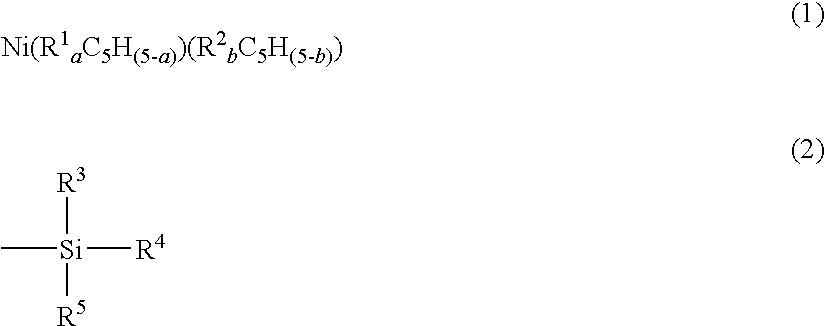Nickel-containing film-forming material and process for producing nickel-containing film
- Summary
- Abstract
- Description
- Claims
- Application Information
AI Technical Summary
Benefits of technology
Problems solved by technology
Method used
Image
Examples
synthesis example 1
[0047]In a 3000 ml flask purged with nitrogen, a tetrahydrofuran solution of cyclopentadienyl sodium (2.0 mol / liter, 800 ml) was dissolved in well-dried tetrahydrofuran (1 liter), and the solution was cooled to 0° C. To the solution, trimethylsilyl chloride (180 g) was dropwise added over a period of 1 hour in a stream of nitrogen, and then they were stirred at 0° C. for 2 hours. Thereafter, a salt was removed by filtration, and the filtrate was distilled to obtain trimethylsilylcyclopentadiene (70 g). The above operations were repeated to obtain 140 g of trimethylsilylcyclopentadiene.
[0048]In a 1000 ml flask purged with nitrogen, trimethylsilylcyclopentadiene (86 g) was dissolved in well-dried tetrahydrofuran (500 ml), and the solution was cooled to 0° C. To the solution, a hexane solution of n-butyllithium (2.6 mol / liter, 250 ml) was dropwise added over a period of 2 hours, and then they were heated to room temperature with stirring them for 1 hour to obtain a tetrahydrofuran solu...
example 1
[0054]By the use of an apparatus shown in FIG. 1, formation of a nickel silicide film by a CVD method using bis(trimethylsilylcyclopentadienyl)nickel obtained in Synthesis Example 1 was carried out on a silicon substrate.
[0055]In a raw material container, bis(trimethylsilylcyclopentadienyl)nickel was placed, then the container was heated to 60° C., and as a carrier gas, a hydrogen gas was made to flow into a reaction container at a flow rate of 400 ml / min. The pressure in the system had been reduced to 10 to 20 Torr, and the substrate placed in the reaction container had been heated to 300° C.
[0056]Using an X-ray photoelectron spectrometer (XPS), composition of the film was examined, and as a result, presence of nickel and silicon was confirmed. Further, from the measurement using an X-ray diffraction apparatus, it was confirmed that this film was a nickel silicide film.
synthesis example 2
[0057]In a 1000 ml flask purged with nitrogen, trimethylsilylcyclopentadiene (69 g) synthesized in Synthesis Example 1 and cyclopentadiene (33 g) were dissolved in well-dried tetrahydrofuran (500 ml), and the solution was cooled to 0° C. To the solution, a hexane solution of n-butyllithium (2.6 mol / liter, 380 ml) was dropwise added over a period of 1 hour, and then they were heated to room temperature with stirring them for 1 hour to obtain a tetrahydrofuran solution of trimethylsilylcyclopentadienyl sodium and cyclopentadienyl sodium.
[0058]Separately from the above, in a 2000 ml flask purged with nitrogen, 65 g of nickel (II) chloride was suspended in well-dried tetrahydrofuran (500 ml). To this solution, the tetrahydrofuran solution of trimethylsilylcyclopentadienyl sodium and cyclopentadienyl sodium previously prepared was dropwise added over a period of 1 hour, and then they were allowed to react with each other at 60° C. for 5 hours. The resulting solution was cooled to room te...
PUM
| Property | Measurement | Unit |
|---|---|---|
| Structure | aaaaa | aaaaa |
Abstract
Description
Claims
Application Information
 Login to View More
Login to View More - R&D
- Intellectual Property
- Life Sciences
- Materials
- Tech Scout
- Unparalleled Data Quality
- Higher Quality Content
- 60% Fewer Hallucinations
Browse by: Latest US Patents, China's latest patents, Technical Efficacy Thesaurus, Application Domain, Technology Topic, Popular Technical Reports.
© 2025 PatSnap. All rights reserved.Legal|Privacy policy|Modern Slavery Act Transparency Statement|Sitemap|About US| Contact US: help@patsnap.com



